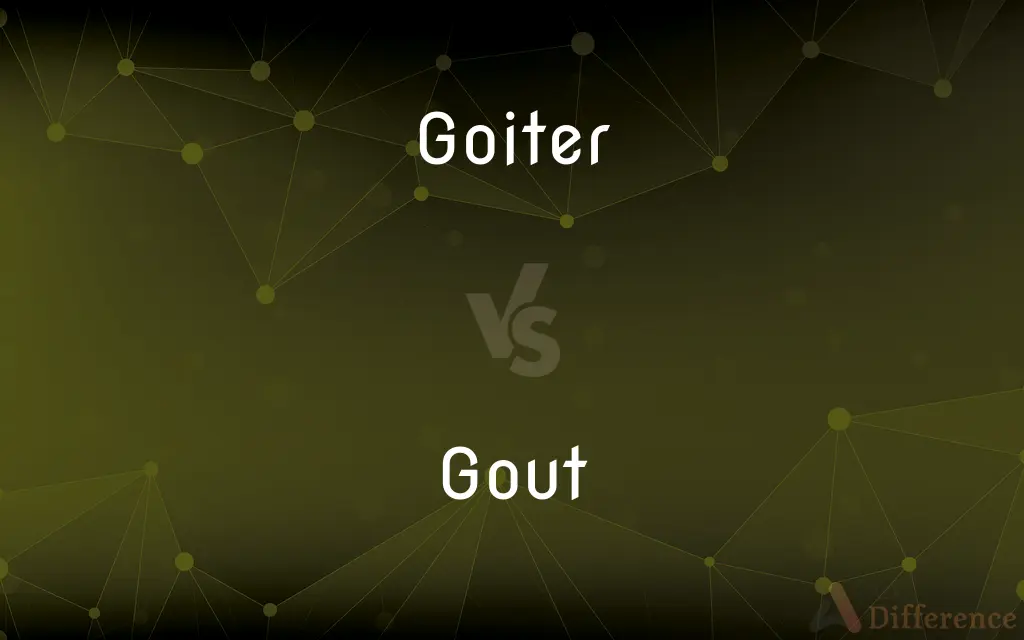Goiter vs. Gout — What's the Difference?
By Tayyaba Rehman — Updated on November 7, 2023
Goiter is an enlargement of the thyroid gland, while gout is a form of inflammatory arthritis.

Difference Between Goiter and Gout
Table of Contents
ADVERTISEMENT
Key Differences
A goiter is an abnormal enlargement of the thyroid gland, which is located in the neck. It's often visible as a bulge and can be due to iodine deficiency, autoimmune disease, or other factors. Gout, on the other hand, is a painful form of arthritis that results from the deposition of uric acid crystals in the joints, typically affecting the big toe but can involve other joints as well.
Goiters can cause symptoms related to their size, such as difficulty swallowing or breathing if they're large enough. Conversely, gout causes intense joint pain, swelling, and redness during flare-ups. While both conditions can cause discomfort, the nature and location of the discomfort are quite different; goiters affect the neck, while gout affects the joints.
Treatment for goiter may involve dietary changes, medication, or surgery, depending on its cause and severity. Gout treatment typically involves medication to reduce inflammation and lower uric acid levels, along with lifestyle modifications. While both may require long-term management strategies, the specific treatments are distinct and cater to the underlying pathologies of each condition.
While goiter can be associated with either hypo- or hyperthyroidism, reflecting under- or over-production of thyroid hormones, gout is associated with metabolic issues that affect uric acid levels. Both conditions can have significant impacts on quality of life but through very different mechanisms: hormonal balance for goiter and metabolic homeostasis for gout.
The prevalence of goiter varies widely around the world, often influenced by dietary iodine intake. Gout prevalence is influenced by dietary factors as well but is also strongly related to genetic factors and other health conditions like obesity and hypertension. Both conditions can be managed with appropriate medical care and lifestyle adjustments.
ADVERTISEMENT
Comparison Chart
Definition
Enlargement of the thyroid gland.
A form of arthritis from uric acid crystal deposition.
Primary Cause
Iodine deficiency, thyroid dysfunction.
High levels of uric acid.
Symptoms
Swollen neck, possible thyroid dysfunction.
Joint pain, swelling, redness.
Affected Area
Neck/thyroid gland.
Joints, often the big toe.
Treatment Approaches
Dietary changes, medication, surgery.
Anti-inflammatory medication, lifestyle changes.
Compare with Definitions
Goiter
Abnormal thyroid gland enlargement
The doctor could see the goiter on her neck.
Gout
Arthritis from uric acid crystals
After the diagnosis, he learned his joint pain was due to gout.
Goiter
Associated with thyroid dysfunction
The patient's hyperthyroidism was accompanied by a goiter.
Gout
Uric acid buildup in joints
Gout is caused by the buildup of uric acid in the joints.
Goiter
Can result from iodine deficiency
Lack of dietary iodine can lead to the development of a goiter.
Gout
Managed by diet and medication
To manage his gout, he changed his diet and took medication.
Goiter
Visible neck swelling
The prominent swelling on her neck was diagnosed as a goiter.
Gout
A disturbance of uric-acid metabolism occurring chiefly in males, characterized by painful inflammation of the joints, especially of the feet and hands, and arthritic attacks resulting from elevated levels of uric acid in the blood and the deposition of urate crystals around the joints. The condition can become chronic and result in deformity.
Goiter
May cause difficulty swallowing
His goiter was getting large enough to affect his swallowing.
Gout
Can cause severe joint pain
She was awakened by intense joint pain, a symptom of her gout.
Goiter
A noncancerous enlargement of the thyroid gland, visible as a swelling at the front of the neck, that is often associated with iodine deficiency. Also called struma.
Gout
Gout is a form of inflammatory arthritis characterized by recurrent attacks of a red, tender, hot, and swollen joint. Pain typically comes on rapidly, reaching maximal intensity in less than 12 hours.
Goiter
Alternative spelling of goitre
Gout
A large blob or clot
"and makes it bleed great gouts of blood" (Oscar Wilde).
Goiter
An enlargement of the thyroid gland, on the anterior part of the neck, usually resulting from iodine deficiency; bronchocele. It is frequently associated with cretinism, and was at one time common in mountainous regions, especially in certain parts of Switzerland. The incidence of goiter has been substantially reduced by addition of iodine to ceratin foods, such as salt.
Gout
An extremely painful inflammation of joints, especially of the big toe, caused by a metabolic defect resulting in the accumulation of uric acid in the blood and the deposition of urates around the joints.
Goiter
Abnormally enlarged thyroid gland; can result from under-production or over-production of hormone or from a deficiency of iodine in the diet
Gout
A spurt or splotch.
Gout
(rare) A disease of wheat and cornstalks, caused by insect larvae.
Gout
(obsolete) taste; relish
Gout
(intransitive) To spurt.
Gout
A drop; a clot or coagulation.
On thy blade and dudgeon gouts of blood.
Gout
A constitutional disease, occurring by paroxysms. It consists in an inflammation of the fibrous and ligamentous parts of the joints, and almost always attacks first the great toe, next the smaller joints, after which it may attack the greater articulations. It is attended with various sympathetic phenomena, particularly in the digestive organs. It may also attack internal organs, as the stomach, the intestines, etc. It is an inherited disease of purine metaboism, which causes an increased level of uric acid in the blood, and leads to deposition of crystals of sodium urate in cartilage within joints and in connective tissue. It can be alleviated by a diet low in purines, and is treated by drugs which block formation of uric acid.
Gout
A disease of cornstalks. See Corn fly, under Corn.
Gout
Taste; relish.
Gout
A painful inflammation of the big toe and foot caused by defects in uric acid metabolism resulting in deposits of the acid and its salts in the blood and joints
Gout
Often affects the big toe
His big toe was swollen, a classic sign of gout.
Common Curiosities
Can goiter be prevented?
Adequate dietary iodine intake can prevent many goiters.
Is goiter always caused by iodine deficiency?
No, it can also result from autoimmune diseases or other thyroid issues.
What are the symptoms of a goiter?
Symptoms may include a visible swelling in the neck and potential thyroid dysfunction.
What is gout?
Gout is an inflammatory arthritis caused by excess uric acid in the joints.
Is gout hereditary?
Yes, genetics can play a role in gout susceptibility.
How can gout be managed?
Management includes medication, dietary changes, and maintaining a healthy weight.
What exactly is a goiter?
A goiter is an abnormal growth of the thyroid gland.
How is goiter treated?
Treatments can include dietary changes, medications, or even surgery.
What triggers gout attacks?
Triggers can include certain foods, alcohol, or dehydration.
Can gout affect other areas besides the big toe?
Yes, gout can affect other joints like ankles, knees, and wrists.
Can children get goiters?
Yes, children can develop goiters, but the causes may differ from adults.
Is there a cure for gout?
While there's no cure, gout can be effectively managed with treatment.
What foods should be avoided with gout?
Foods high in purines, like red meat and seafood, should be limited.
Are goiters cancerous?
Most goiters are benign, but some can be associated with thyroid cancer.
Does goiter cause pain?
Goiters are usually painless but can cause discomfort if they're large.
Share Your Discovery

Previous Comparison
Single vs. Alone
Next Comparison
Motivation vs. MoraleAuthor Spotlight
Written by
Tayyaba RehmanTayyaba Rehman is a distinguished writer, currently serving as a primary contributor to askdifference.com. As a researcher in semantics and etymology, Tayyaba's passion for the complexity of languages and their distinctions has found a perfect home on the platform. Tayyaba delves into the intricacies of language, distinguishing between commonly confused words and phrases, thereby providing clarity for readers worldwide.














































